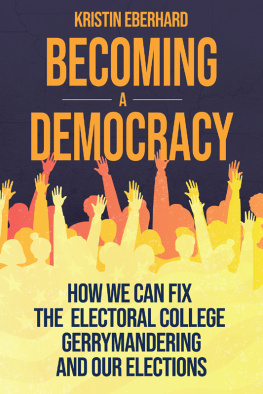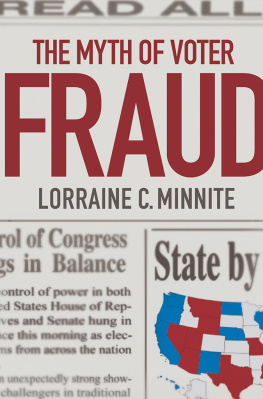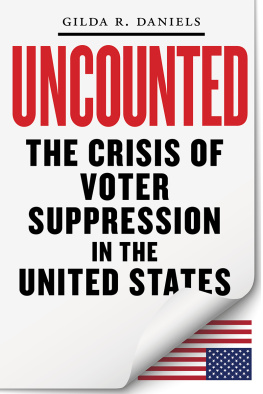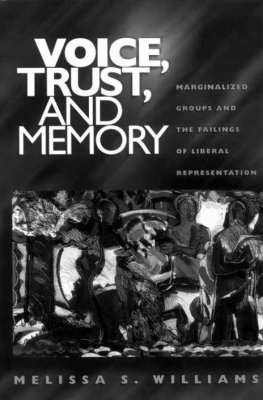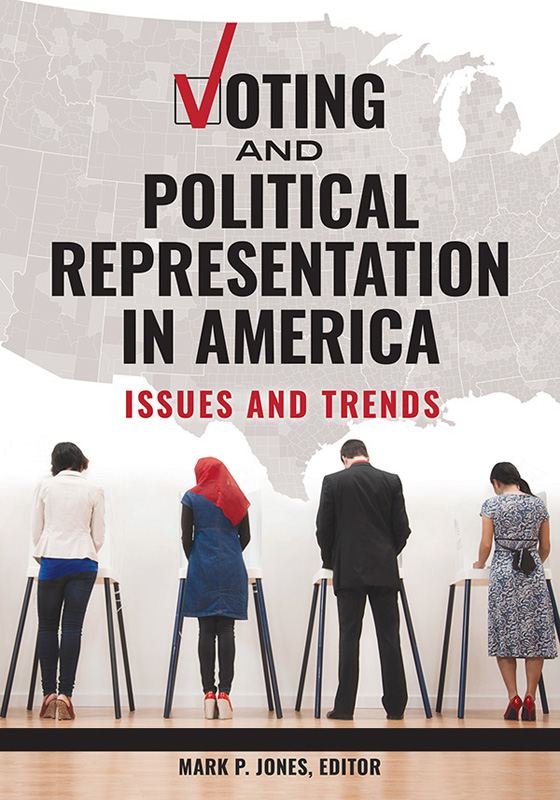Voting and Political
Representation in America
Copyright 2020 by ABC-CLIO, LLC
All rights reserved. No part of this publication may be reproduced, stored in a retrieval system, or transmitted, in any form or by any means, electronic, mechanical, photocopying, recording, or otherwise, except for the inclusion of brief quotations in a review, without prior permission in writing from the publisher.
Library of Congress Cataloging-in-Publication Data
Names: Jones, Mark P., 1967 author.
Title: Voting and political representation in America : issues and trends / Mark P. Jones.
Description: Santa Barbara : ABC-CLIO, 2020. | Includes bibliographical references and index. | Contents: v. 1. v. 2.
Identifiers: LCCN 2019048667 (print) | LCCN 2019048668 (ebook) | ISBN 9781440860843 (set) | ISBN 9781440860867 (v. 1 ; hardcover) | ISBN 9781440860874 (v. 2 ; hardcover) | ISBN 9781440860850 (ebook)
Subjects: LCSH: VotingUnited States. | SuffrageUnited States. | Election lawUnited States. | Political participationUnited States. | Representative government and representationUnited States. | GerrymanderingUnited States. | Campaign fundsLaw and legislationUnited States.
Classification: LCC KF4891 .J63 2020 (print) | LCC KF4891 (ebook) | DDC 324.60973dc23
LC record available at https://lccn.loc.gov/2019048667
LC ebook record available at https://lccn.loc.gov/2019048668
ISBN:978-1-4408-6084-3 (set)
978-1-4408-6086-7 (vol. 1)
978-1-4408-6087-4 (vol. 2)
978-1-4408-6085-0 (ebook)
242322212012345
This book is also available as an eBook.
ABC-CLIO
An Imprint of ABC-CLIO, LLC
ABC-CLIO, LLC
147 Castilian Drive
Santa Barbara, California 93117
www.abc-clio.com
This book is printed on acid-free paper 
Manufactured in the United States of America
Contents
VOLUME ONE
VOLUME TWO
On July 4, 1776, the thirteen American colonies formally declared their independence from Great Britain. Over the course of the next 243 years, the United States expanded westward, purchasing some territory (e.g., the Louisiana Purchase) and taking other territory by force (e.g., the Treaty of Guadalupe-Hidalgo). Along the way, it accepted two independent countries (Texas and Hawaii) as states and experienced a civil war and the short-lived secessionist Confederate States of America. And, in 2020, territorial issues have not completely died away, as many residents of the District of Columbia and Puerto Rico continue to advocate for statehood.
Throughout U.S. history, voting rights, elections, and representation have evolved considerably. Voting rights were expanded, and representation of women, African Americans, Latinos, Asian Americans, Native Americans, and members of the LGBTQ community improved, although in all cases, descriptive representation of the members of these groups in the corridors of power has not reached levels proportionate with their presence in the population.
The political party system also evolved with the formation of a two-party system featuring the Democratic Party and the Whig Party, which was then supplanted by a two-party system featuring the Democratic Party and the Republican Party; this two-party duopoly continues to dominate the countrys political party system in 2020. At various times, third parties emerged and experienced some modest success, such as the Populist Party at the end of the nineteenth century or George Wallaces American Independent Party in the 1968 presidential election, but none have ever threatened the dominance of the Democratic and Republican parties.
During this same time period, the United States moved from the use of party-supplied ballots to government-supplied ballots (the Australian Ballot), with a wide variety of voting devices employed. In the aftermath of the 2000 presidential election, the Help America Vote Act of 2002 carried out the most sweeping change in voting devices in modern U.S. history, dispensing with punch-card and mechanical lever voting systems and generally replacing them with a variety of methods of electronic voting. At the same time, over the last thirty years, it has become easier for Americans to register to vote via initiatives such as the federal Motor Voter act of 1993 and state-level adoptions of online voter registration.
Some aspects of the U.S. electoral system have remained relatively constant over time, such as the use of the Electoral College to elect the president and the use of single-member plurality districts for most legislative elections. Other aspects, however, have changed notably, including the democratization of the presidential and legislative candidate selection process within the major political parties over time, as well as more recent reforms designed to reduce partisan polarization, such as the adoption of the top-two primary system and the creation of independent redistricting commissions.
VOTING RIGHTS
Over the course of U.S. history, there has been a steady expansion of voting rights. While there have been some reversals and constriction of voting rights at times, the general trend has consistently been toward the expansion of U.S. citizens inalienable right of suffrage.
In the first U.S. presidential election, held between December 15, 1788, and January 10, 1789, only white men over the age of twenty-one who owned land were eligible to vote. At the time of the first presidential election, there were no national-level rules regarding suffrage rights, and states were free to determine who would have the right to vote and who would not. At this time, approximately only one in twenty U.S. residents was eligible to vote.
Shortly after the 1788 to 1789 presidential election, Congress passed the 1790 Naturalization Law. This legislation limited applications for U.S. citizenship by immigrants to free white people of good character who had resided in the United States for at least two years. Citizenship granted to parents was also automatically extended to their minor (under twenty-one years of age) children, regardless of whether or not they had been born in the United States. During the first half of the nineteenth century, suffrage rights were gradually expanded state by state to white men who were twenty-one or older who did not own land, with North Carolina being the last state to expand suffrage to non-property owners in 1856.
During the first half of the nineteenth century, the United States also experienced a substantial territorial expansion, including the Louisiana Purchase of 1803 and the Mexican-American War, which began in 1846 and ended in February 1848 with the signing of the Treaty of Guadalupe-Hidalgo by the governments of the United States and Mexico. The treaty increased the territory of the United States by over 500,000 square miles, annexing land that today makes up some or all of the current states of Arizona, California, Colorado, Nevada, New Mexico, Utah, and Wyoming. At the time, U.S. citizenship was extended to Mexicans living in this new territory, but the ability of these new citizens to exercise their suffrage rights was limited by laws that restricted voting to those who spoke English and informal tactics of voter suppression, ranging from threats and vandalism to murder.
The U.S. Civil War (18611865) profoundly impacted voting and representation in the United States. Following the wars end, three amendments to the Constitution altered the electorate, granting citizenship and voting rights to more than four million African Americans, most having just been freed from slavery. These rights were still limited to men.


